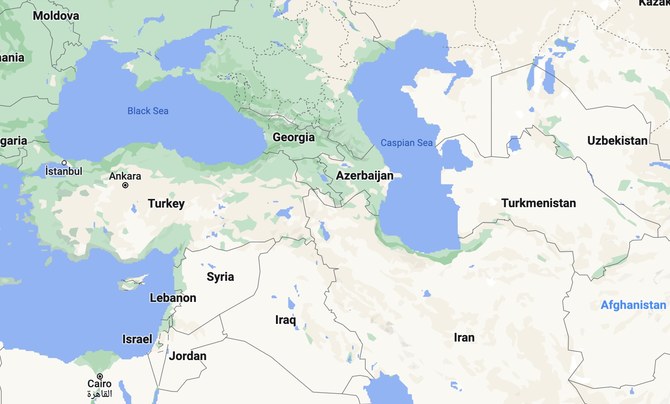A trans-Caspian gas pipeline could solve Europe’s energy crisis

https://arab.news/z3fk8
Last week, the foreign ministers of Turkey, Azerbaijan and Turkmenistan gathered in Ankara for a trilateral meeting. Top of the agenda was energy.
In the aftermath of Russia’s invasion of Ukraine, global energy markets are in disarray. Nowhere is this being felt more acutely than in Europe. Over the years, the continent has failed to diversify its sources of oil and gas, while putting too much faith in renewable energy sources that remain costly and less productive. This has led to an unhealthy dependency on Russian oil and gas, which gives Moscow the geopolitical upper hand.
Now is the time for Europe to start looking for better options for its energy imports. Thankfully, there are quite a few possibilities, including North Africa, the Eastern Mediterranean, and even liquefied natural gas exports from as far away as the US and the Gulf.
However, one area that Europe should pay special attention to is the region around the Caspian Sea. This is why the meeting of Turkey, Azerbaijan and Turkmenistan’s foreign ministers was so important.
The Caspian region has an estimated 292 trillion cubic feet of natural gas in proven and probable reserves. It also has extensive and reliable pipeline infrastructure connecting it to markets in Europe.
However, one important piece of the Caspian energy puzzle remains missing: A trans-Caspian gas pipeline linking Turkmenistan on the east coast with Azerbaijan on the west.
Turkmenistan is thought to have the fourth-largest reserves of natural gas in the world. A pipeline is the only economically viable way to move natural gas across the Caspian Sea because the alternative, turning it into LNG, is too costly for transport over such a short distance. Without a pipeline across the sea, therefore, there is no profitable way to transport gas from Central Asia to Europe without first going through Russia.
The idea of constructing a natural gas pipeline across the Caspian Sea has been debated for decades. However, there are four reasons why now is the right time to finally build one.
Firstly, Turkmenistan is out of money. Ashgabat has relied too heavily on natural gas exports to too few customers, mainly Russia and China. The country is embroiled in an economic crisis. Those international investors that could enter the country are reluctant to do so because little has been done to improve the business climate, privatize state-owned industries, or combat rampant corruption.
The greatest potential for Turkmenistan to turn around its dire economic situation lies with its energy resources. Former President Gurbanguly Berdimuhamedov recently handed power to his son, Serdar. It remains to be seen whether he will adopt a more open-minded approach to foreign investment than his father but one thing is certain: Turkmenistan needs new revenue streams and a trans-Caspian gas pipeline could help.
With Nord Stream 2 now dead, Europe looking for energy alternatives, Russia and Iran distracted, and Azerbaijan and Turkmenistan willing, now is the time to finally make this project a reality.
Luke Coffey
Secondly, Russia and Iran are distracted. Neither country, both of which are Caspian littoral states, supported the idea of a gas pipeline under the sea in the past. They both knew that it would cut them out of any gas deals with Europe. However, neither of them is currently in much of a position to do much about a trans-Caspian pipeline project.
In the face of economic sanctions, Russia’s economy remains fragile. While popular support for the war in Ukraine remains high for now, it is likely domestic unrest will increase as sanctions begin to bite and the war drags on.
Iran is facing similar economic problems at home, too. President Ebrahim Raisi is dealing with mounting public protests across the country. Meanwhile, a new nuclear deal with the US seems unlikely. Therefore it is likely that both Moscow and Tehran have bigger issues to worry about than a trans-Caspian gas pipeline.
Thirdly, most of the infrastructure is already in place to deliver gas from Turkmenistan to Europe. On the western side of the Caspian Sea, the Southern Gas Corridor started operations in 2020. This network of pipelines, running for 3,340 km across seven countries, has the potential to supply 60 billion cubic meters of natural gas annually to Europe.
On the eastern shore of the Caspian Sea, Ashgabat has already constructed its so-called East-West pipeline, a 780 km natural gas pipeline connecting Mary province in the east with the country’s Caspian coast. It has the potential to transport 30 billion cubic meters annually.
Finally, most of the legal obstacles to building a pipeline no longer exist. The Convention on the Legal Status of the Caspian Sea, signed by all five Caspian littoral states in 2018, allows pipelines to be established with the consent of only the countries involved in the project.
As mentioned above, Iran and Russia oppose the idea of a pipeline and so argued that any such project must first have the agreement of all five littoral states. The new convention could finally give the green light to a trans-Caspian pipeline once the interested parties, in this case Turkmenistan and Azerbaijan, reach an agreement.
The Caspian region has come a long way since its first pipeline was constructed in 1906. Today, there is a vast network of pipelines moving oil and gas. A trans-Caspian gas pipeline, coupled with the Southern Gas Corridor, would alter the geopolitical landscape in the region and beyond.
With Nord Stream 2, a previously planned natural gas pipeline from Russia to Germany, now dead as a result of the invasion of Ukraine, Europe looking for energy alternatives, Russia and Iran distracted, and Azerbaijan and Turkmenistan willing, now is the time to finally make this project a reality.
• Luke Coffey is the director of the Douglas and Sarah Allison Center for Foreign Policy at the Heritage Foundation. Twitter: @LukeDCoffey









































